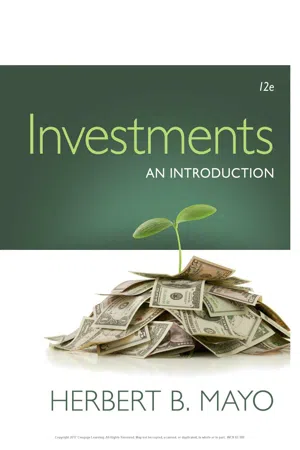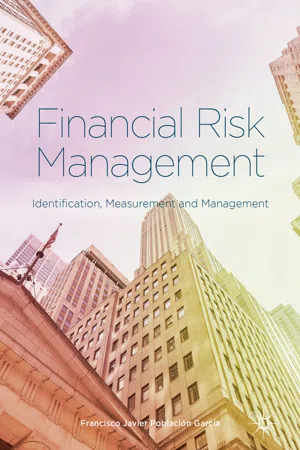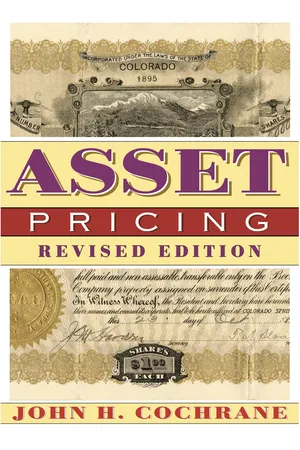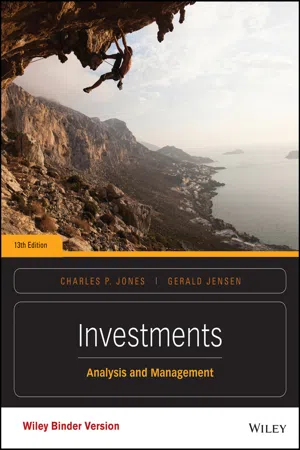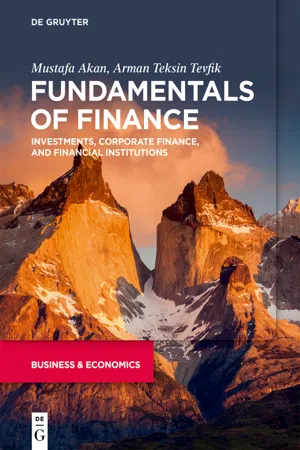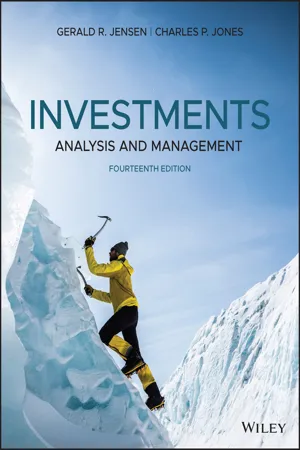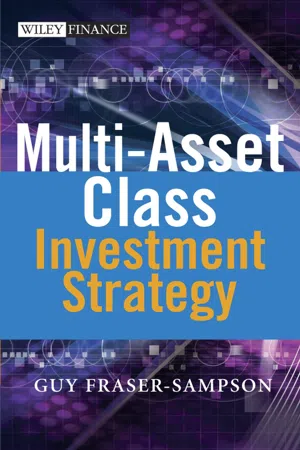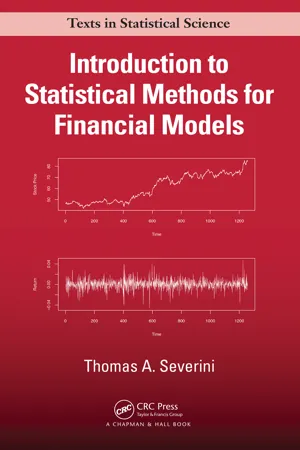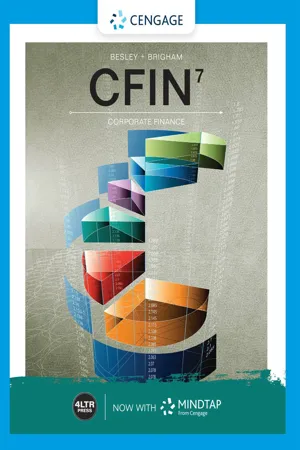Business
CAPM Assumptions
The Capital Asset Pricing Model (CAPM) is based on several key assumptions, including perfect capital markets, investors with homogeneous expectations, no taxes or transaction costs, and unlimited borrowing and lending at the risk-free rate. These assumptions provide the foundation for the model's calculations of expected returns and risk premiums for individual assets within a diversified portfolio.
Written by Perlego with AI-assistance
Related key terms
1 of 5
10 Key excerpts on "CAPM Assumptions"
- No longer available |Learn more
Investments
An Introduction
- Herbert Mayo(Author)
- 2016(Publication Date)
- Cengage Learning EMEA(Publisher)
That is, the concept is applied in both a macro context that specifies the relationship between risk and the return on a portfolio and a micro context that specifies the relationship between risk and the return on a specific asset. The macro aspect of the CAPM is the development of the capital market line . Figure 5.11 begins with all the possible efficient portfolios of risky securities and adds C AP ITAL M ARKE T L INE FIGURE 5.11 Retur n (%) r f Z X Y A B Risk: Por tfolio Standard Deviation ( p ) σ ( ( p p S OU RCE : © Cengage Learning 3 For the seminal work on CAPM, see William Sharpe, “Capital Asset Prices: A Theory of Market Equilibrium,” Journal of Finance (September 1964): 425–442; John Lintner, “The V aluation of Risk Assets and the Selection of Risk I nvestments in Stock Portfolios and Capital Budgets,” Review of Economics and Statistics (February 1965): 13–37; and Jan Mossin, “Equilibrium in a Capital Asset Market,” Econometrica (October 1966): 768–783. The contributions of Markowitz and Sharpe to the analysis of risk and the development of portfolio theory are so important that they, along with Merton Miller, were awarded the Nobel Prize in economics in 1990. Copyright 2017 Cengage Learning. All Rights Reserved. May not be copied, scanned, or duplicated, in whole or in part. WCN 02-300 C H A P T E R F I V E Risk and Portfolio Management 161 line AB , which begins at r f on the Y-axis and is tangent to the efficient frontier. AB is the capital market line specified by the Capital Asset Pricing Model. Each point on the line represents a combination of the risk-free security and a portfolio encompassing risky securities. If investors bear no risk and invest their entire portfolios in risk-free assets, they should earn a return equal to r f r r . As investors substitute risky securities for the risk-free assets, both risk and return increase (i.e., there is movement along the capital market line). - eBook - PDF
Financial Risk Management
Identification, Measurement and Management
- Francisco Javier Población García(Author)
- 2017(Publication Date)
- Palgrave Macmillan(Publisher)
Part V Financial Implications of Risk 16 The CAPM 16.1 Basic Concepts This chapter will examine how the types of risk previously discussed affect the value of a company’s shares, while Chap. 17 will examine how they affect the value of the company as a whole, shares plus debt. In order to see how these risks affect the value of a company’s shares, this chapter will analyse the capital asset pricing model, known as CAPM, one of the most common tools used in finance to determine the required rate of return for a particular asset based on its risks. Three influential economists—William Sharpe, John Lintner and Jan Mossin—worked simultaneously, but separately, on the design of the model, publishing their investigations in different journals between 1964 and 1966. What attracted them to this topic was their interest in the development of models to explain and predict the behaviour of financial assets, as all had been influenced by Harry Markowitz’s portfolio theory, published in 1952 and reformulated in 1959, in which the advantages of diversifying investments to reduce risk are highlighted. The idea of diversifying investments involves allocating resources in different areas, such as industry, construction, technology, natural 323 © The Author(s) 2017 F.J. Población García, Financial Risk Management, DOI 10.1007/978-3-319-41366-2_16 resources, research and development (R&D), health and so on. Markowitz called this a portfolio, and the thesis was that the better diversified the portfolio was, the better prepared it would be to face risks. The CAPM took this idea one step forward by looking to maximise the return of every share in order to achieve an even more profitable portfolio. For this important contribution to the development of financial economics, William Sharpe received the Nobel Prize in Economics (jointly with Harry Markowitz and Merton Miller) in 1990. - eBook - PDF
Asset Pricing
Revised Edition
- John H. Cochrane(Author)
- 2009(Publication Date)
- Princeton University Press(Publisher)
[For example, see equation (8.3).] In empirical applications, we can also pick a and b to best price larger cross sections of assets. We do not have good data on, or even a good empirical definition for, the return on total wealth. It is conventional to proxy R W by the return on a broad-based stock portfolio such as the value-or equally-weighted NYSE, S&P500, etc. The CAPM is, of course, most frequently stated in equivalent expected return-beta language, E ( R i ) = γ + β i , R W E ( R W ) − γ . This section briefly describes some classic derivations of the CAPM. Again, we need to find assumptions that defend which factors proxy for marginal utility ( R W here), and assumptions to defend the linearity between m and the factor. I present several derivations of the same model. Many of these derivations use classic and widely applicable modeling assumptions. You can also see that various sets of assumptions can often be used to get to the same place. By seeing several derivations, you can see how one assumption can be traded for another. For example, the CAPM does not require normal distributions, if one is willing to swallow quadratic utility instead. 9.1. Capital Asset Pricing Model (CAPM) 153 Two-Period Quadratic Utility Two-period investors with no labor income and quadratic utility imply the CAPM. Investors have quadratic preferences and only live two periods, U ( c t , c t + 1 ) = − 1 2 ( c ∗ − c t ) 2 − 1 2 β E ( c ∗ − c t + 1 ) 2 . (9.2) Their marginal rate of substitution is thus m t + 1 = β u ( c t + 1 ) u ( c t ) = β ( c ∗ − c t + 1 ) ( c ∗ − c t ) . The quadratic utility assumption means marginal utility is linear in consump-tion. Thus, we have achieved one target of the derivation, linearity. Investors are born with wealth W t in the first period and earn no labor income. They can invest in N assets with prices p i t and payoffs x i t + 1 , or, to keep the notation simple, returns R i t + 1 . - eBook - PDF
Investments
Analysis and Management
- (Author)
- 2016(Publication Date)
- Wiley(Publisher)
Thus, the CAPM is frequently referenced as a single‐factor model. According to the CAPM, the only factor that differentiates the returns of one asset from another asset is the asset’s beta. TESTS OF THE CAPM The conclusions of the CAPM are entirely sensible: 1. Expected return and risk are positively related—greater risk implies greater expected return. 2. The relevant risk for a security is a measure of its effect on portfolio risk. The question, therefore, is how well the theory works. After all, the assumptions on which capital market theory (CMT) rest are, for the most part, unrealistic. To assess the validity of this or any other theory, empirical tests must be performed. If the CAPM is valid, β x β y Beta X Y Z Expected (required) return E ( R y ) E ( R y 1 ) E ( R x ) RF E ( R x 1 ) FIGURE 9-8 Overvalued and Undervalued Securities Using the SML Arbitrage Pricing Theory 241 and the market tends to balance out so that the model provides reasonably accurate forecasts for security returns, equations of the following type can be estimated: R a a i i 1 2 (9-4) where R i i the average return on security over some number of periods the estimated beta for security i i When Equation 9-4 is estimated, a 1 should approximate the average RF during the peri-ods studied, and a 2 should approximate the average market risk premium during the periods studied. An extensive literature exists involving tests of CMT, in particular, the CAPM. Although it is not possible to summarize the scope of this literature entirely and to reconcile findings from different studies that seem to be in disagreement, the following points represent a reasonable consensus of the empirical results 7 : 1. The SML appears to be linear; that is, the trade‐off between expected (required) return and risk is an upward‐sloping straight line. 2. The intercept term, a 1 , is generally found to be higher than RF. 3. The slope of the CAPM, a 2 , is generally found to be less steep than posited by the theory. - eBook - PDF
Fundamentals of Finance
Investments, Corporate Finance, and Financial Institutions
- Mustafa Akan, Arman Teksin Tevfik(Authors)
- 2020(Publication Date)
- De Gruyter(Publisher)
6 Risk, Rate of Return, and Portfolio Theory 6.1 Introduction Return and risk are two key dimensions for investment decisions. To maximize in-vestment returns for a given level of risk, or equivalently, to minimize investment risk for a given level of return, is the ultimate goal of investors. A way to achieve this goal is to construct a portfolio. It is also under the framework of portfolio theory that the relationship between return and risk can be quantified in equilibrium. This is the famous Capital Asset Pricing Model (CAPM), which is also known as the Sharpe-Lintner-Mossin form of Capital Asset Pricing Model. 1 6.2 Efficient Markets This section explains why market efficiency is the key element to the economic well-being of societies and discusses three aspects of market efficiency. 2 – Allocational efficiency. Allocational efficiency exists when funds flow to their highest valued use. Directing funds to highest NPV (profitable) projects bene-fits not only corporations and their employees, but also consumers who benefit from lower prices and governments that collect more taxes on higher profits. Societies with high levels of corruption tend to have low allocational efficiency and, as a result, tend to be poorer societies. – Operational efficiency. An operationally efficient market has the lowest possible transaction cost. In addition to the cost of trade (such as commissions), trans-action costs also include search costs, information costs, and opportunity costs. The lower the transaction cost, the more freely investable funds will flow to their most productive use. 1 For more information, see: John Lintner, “ The Aggregation of Investor ’ s Diverse Judgements and Preferences in Purely Competitive Security Markets, ” Journal of Financial and Quantitative Analysis , IV, no. 4, Dec. 1969, pp. 347 – 400; Jan Mossin, “ Equilibrium in Capital Asset Market, ” Econometrica , 34, Oct. - eBook - PDF
Investments
Analysis and Management
- Gerald R. Jensen, Charles P. Jones(Authors)
- 2019(Publication Date)
- Wiley(Publisher)
Beta is the only company-specific factor in the CAPM; therefore, risk is the only asset-specific forecast that must be made. Thus, the CAPM is frequently referenced as a single-factor model. According to the CAPM, the only factor that differentiates the returns of one asset from another asset is the asset’s beta. β x β y Beta X Y Z Expected (required) return E(R y ) E(R y 1) E(R x ) RF E(R x 1) FIGURE 9.8 Overvalued and undervalued securities using the SML 244 Chapter 9 Capital Market Theory and Asset Pricing Models Tests of the CAPM The conclusions of the CAPM are entirely sensible: 1. Expected return and risk are positively related—greater risk implies greater expected return. 2. The relevant risk for a security is a measure of its effect on portfolio risk. The question, therefore, is how well the theory works. After all, the assumptions on which capital market theory (CMT) rest are, for the most part, unrealistic. To assess the validity of this or any other theory, empirical tests must be performed. If the CAPM is valid, and the market tends to balance out so that the model provides reasonably accurate forecasts for security returns, equations of the following type can be estimated: R a a i i 1 2 (9-4) where R i i the average return on security over some number of periods the estimated beta for security i i When Equation 9-4 is estimated, a 1 should approximate the average RF during the periods studied, and a 2 should approximate the average market risk premium during the periods studied. An extensive literature exists involving tests of the CAPM. Although it is not possi- ble to summarize the scope of this literature entirely and to reconcile findings from different studies that seem to be in disagreement, the following points represent a reasonable consensus of the empirical results 7 : 1. The SML appears to be linear; that is, the trade-off between expected (required) return and risk is an upward-sloping straight line. - Ivan E Brick(Author)
- 2017(Publication Date)
- WSPC(Publisher)
Assume homogenous expectations. In other words, assume that every investor has the same set of beliefs and therefore M is the optimal portfolio for all investors. For now, suspend your disbelief and let us understand the full implication of this strange assumption. Now remember, in equilibrium (yes, you have to remember your economics) supply of each security must equal to its demand. So every security offered by firms must be held. Therefore if M is the optimal risky portfolio for all individuals, then every security in the market place must be in M. Well, there is one such security and that is the market portfolio. Oh, by the way in the real world people do not have the same expectations. But if we were to add up everyone’s portfolio holding and average them out, would we not get the market portfolio? So I guess assuming homogenous expectations which leads that people hold the market portfolio is not such a bad assumption!The Capital Asset Pricing Model
To get a mathematical representation of equilibrium requires some fancy math. Let us avoid that and note that according to the three assumptions, all investors will invest in the Treasury security and the market portfolio. This implies that all securities will be compared to two benchmarks, the rate of the return of the Treasury security and the risk-free rate. The Capital Asset Pricing Model (henceforth, CAPM) of Lintner, Sharpe and Mossin is a mathematical representation of the market equilibrium discussed in the previous subsection. According to this modelwhere βI is the beta of security I, and it represents the risk of security I. Note that the expected return of security I is a linear combination of the expected return of the market portfolio, E(RM ), and the riskfree rate. Note that [E(RM ) − RF- eBook - PDF
- Guy Fraser-Sampson(Author)
- 2006(Publication Date)
- Wiley(Publisher)
As we will see, that sense is not the ‘risk’ that would be understood by any person in the real world, but in the sense of an arithmetical device which is required in the artificial world of the box to enable the Capital Asset Pricing Model (CAPM) to work. The Capital Asset Pricing Model, which was developed in the early 1960s, forms the basis for the whole of modern investment theory. Though it was first published in 1964 by William Sharpe, similar work was also being done at the same time by others such as Treynor and Lintner, and it built upon the pioneering thinking on portfolio theory already performed by Harry Markowitz in the 1950s (for their work on portfolio theory Sharpe and Markowitz were awarded the Nobel Prize in 1990 jointly with Merton Miller). The measurement and use of ‘risk’ in its artificial and specialised sense is a key feature of the CAPM. The CAPM offers a way of theoretically splitting the risk inherent in holding a portfolio of investments into two different sorts of risk: systematic and specific. That is to say, the risk of holding the ‘market portfolio’ (the ‘systemic’ risk) contrasted with the risk of holding any one individual investment within it (the ‘specific’ risk). 3 The ‘market portfolio’ is really just a notional portfolio representing the market as a whole. For example, a FTSE 100 market portfolio would comprise all the individual shares that make up the FTSE 100, weighted by market capitalisation. However, in order to understand properly how Risk 49 3 Confusingly, some writers talk about the ‘systematic’ risk of any individual asset or group of assets as opposed to ‘market’ risk. They may even say that the systematic risk is the market risk of the individual asset or groups of assets. While there is nothing wrong with these terms, I believe it is less confusing to talk about ‘specific’ and ‘systemic’ as representing the asset (or group of assets) and the market portfolio respectively, and will do so throughout. - Thomas A Severini(Author)
- 2017(Publication Date)
- Chapman and Hall/CRC(Publisher)
Proposition 7.2 may be easily adapted to prove this result.Corollary 7.3. LetR p ∗denote a given portfolio and for any arbitrary asset with return R defineα( R )= E( R )−μ f− β( R )()μ p ∗−μ fwhereandμ p ∗= E(R p ∗)β. Consider the set of assets for which( R )= Cov(∕ VarR ,)R p ∗(R p ∗)α. Then the asset with return( R )= 0R p ∗is in this set and it has the maximum Sharpe ratio among all portfolios formed from assets in this set.7.6 The CAPM without a Risk-Free AssetThe CAPM discussed in this chapter is based on the assumption that all the investors choose a combination of the risk-free asset and a portfolio of risky assets. According to efficient portfolio theory, this portfolio of risky assets is the tangency portfolio for all investors. Thus, the market portfolio is equivalent to the tangency portfolio so that the market portfolio has the properties of the tangency portfolio. It is important to note that the optimality of the tangency portfolio in this context is based on the fact that investors combine their portfolio of risky assets with the risk-free asset.In this section, we consider a version of the CAPM that holds without relying on the existence of a risk-free asset. There are two important implications of this change for the CAPM. The more obvious one is that we cannot include the risk-free rate,μ f- eBook - PDF
- Scott Besley, Eugene Brigham, Scott Besley(Authors)
- 2021(Publication Date)
- Cengage Learning EMEA(Publisher)
As a result, investors penalize the firm by selling their stock, which causes the value of the firm’s stock to decline. In this chapter, we build on the general concept that was introduced in Chapter 5 by showing how the risk premium associated with any investment should be determined (at least in theory). The basis of our discus- sion is Equation 5.2, which we develop further in this chapter as follows: r j 5 Risk-free rate 1 Risk premium 5 r RF 1 (r M 2 r RF )b j 5 CAPM According to the CAPM, investors should not expect to be rewarded for all of the risk associated with an individual investment—that is, its total, or stand- alone, risk—because some risk can be eliminated through diversification. The relevant risk, and thus the risk for which investors should be compensated, is that Olivier Le Moal/Shutterstock.com 187 CHAPTER 8: Risk and Rates of Return Copyright 2022 Cengage Learning. All Rights Reserved. May not be copied, scanned, or duplicated, in whole or in part. Due to electronic rights, some third party content may be suppressed from the eBook and/or eChapter(s). Editorial review has deemed that any suppressed content does not materially affect the overall learning experience. Cengage Learning reserves the right to remove additional content at any time if subsequent rights restrictions require it. portion of the total risk that cannot be diversified away. Thus, in this chapter we showed the following: Systematic risk is represented by an investment’s beta coefficient, b, in Equation 8.10. The specific types and sources of risk to which a firm or an investor is exposed are numerous, and vary considerably depending on the situation. A detailed discussion of all the different types of risks and the techniques used to evalu- ate risks is beyond the scope of this book.
Index pages curate the most relevant extracts from our library of academic textbooks. They’ve been created using an in-house natural language model (NLM), each adding context and meaning to key research topics.
